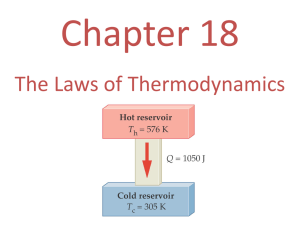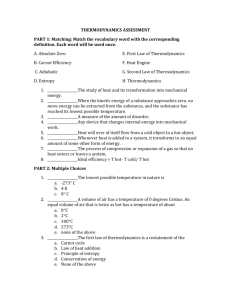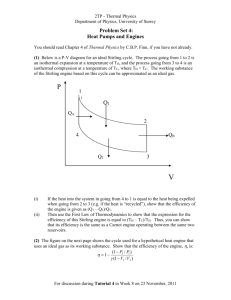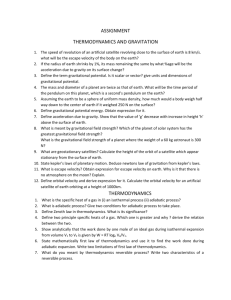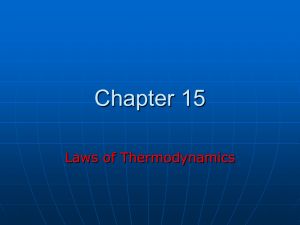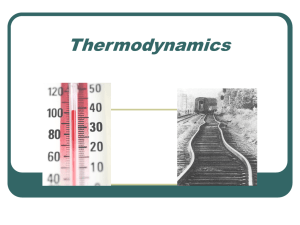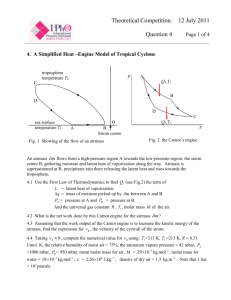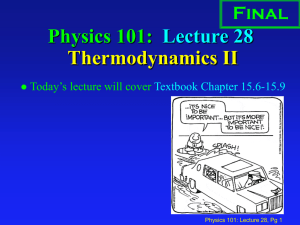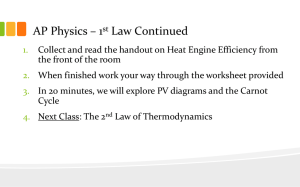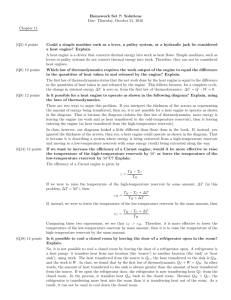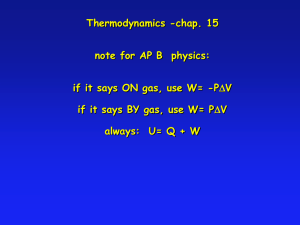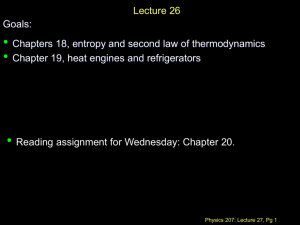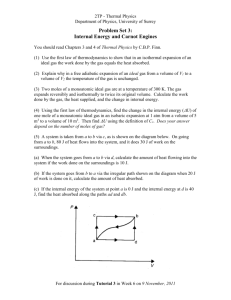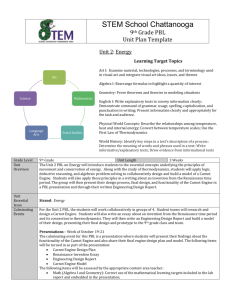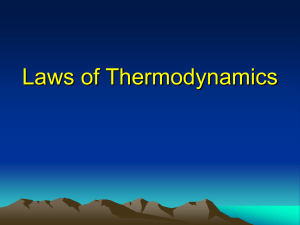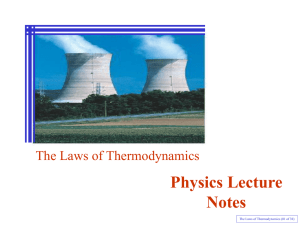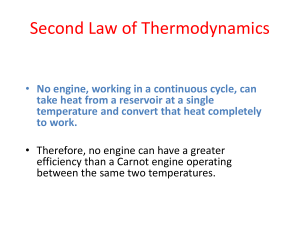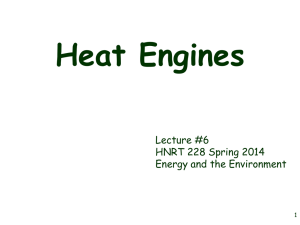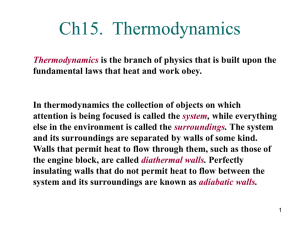Thermal Physics II
advertisement
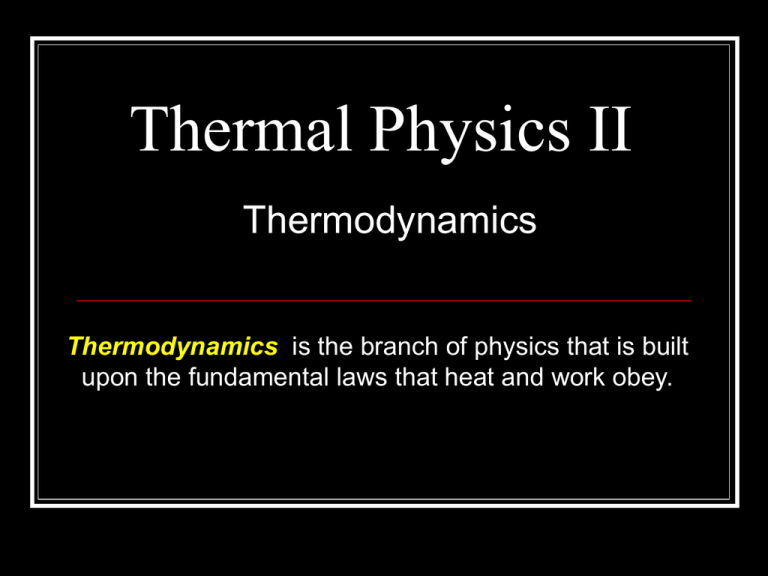
Thermal Physics II Thermodynamics Thermodynamics is the branch of physics that is built upon the fundamental laws that heat and work obey. Terminology The collection of objects on which attention is being focused is called the system, while everything else in the environment is called the surroundings. To understand thermodynamics, it is necessary to describe the state of a system in terms of temperature, pressure, and volume. Terminology Walls that permit heat flow are called diathermal walls, while walls that do not permit heat flow are called adiabatic walls. Two systems are said to be in thermal equilibrium if there is no heat flow between then when they are brought into contact. Temperature is the indicator of thermal equilibrium in the sense that there is no net flow of heat between two systems in thermal contact that have the same temperature. The Zeroth Law of Thermodynamics Two systems individually in thermal equilibrium with a third system are in thermal equilibrium with each other. The First Law of Thermodynamics Suppose that a system gains heat Q and that is the only effect occurring. Consistent with the law of conservation of energy, the internal energy of the system changes: U U f Ui Q Heat is positive when the system gains heat and negative when the system loses heat. The First Law of Thermodynamics If a system does work W on its surroundings and there is no heat flow, conservation of energy indicates that the internal energy of the system will decrease: U U f Ui W Work is positive when it is done by the system and negative when it is done on the system. The First Law of Thermodynamics The internal energy of a system changes due to heat and work: U U f Ui Q W Heat is positive when the system gains heat and negative when the system loses heat. Work is positive when it is done by the system and negative when it is done on the system. Positive and Negative Work In part a of figure, the system gains 1500J of heat and 2200J of work is done by the system on its surroundings. In part b, the system also gains 1500J of heat, but 2200J of work is done on the system. In each case, determine the change in internal energy of the system. (a) U Q W 1500 J 2200 J 700 J (b) U Q W 1500 J 2200 J 3700 J The Second Law of Thermodynamics THE SECOND LAW OF THERMODYNAMICS: THE HEAT FLOW STATEMENT Heat flows spontaneously from a substance at a higher temperature to a substance at a lower temperature and does not flow spontaneously in the reverse direction. The Second Law of Thermodynamics A heat engine is any device that uses heat to perform work. It has three essential features. 1. Heat QH is supplied to the engine at a relatively high temperature from a place called the hot reservoir. 2. Part of the input heat is used to perform work W by the working substance of the engine (such as the gasoline-air mixture in car engines). 3. The remainder of the input heat is rejected as QC to a place called the cold reservoir. The efficiency of a heat engine is defined as the ratio of the work done to the input heat: e W QH If there are no other losses, then QH W QC e 1 QC QH An automobile engine has an efficiency of 22.0% and produces 2510 J of work. How much heat is rejected by the engine? QH W QC W e QH QC QH W QH W e W QC W W e 1 e 1 1 2510 J 1 8900 J 0.220 Carnot’s Principle and the Carnot Engine A reversible process is one in which both the system and the environment can be returned to exactly the states they were in before the process occurred. Nicolas Léonard Sadi Carnot (June 1, 1796 August 24, 1832) was a French physicist and military engineer CARNOT’S PRINCIPLE: AN ALTERNATIVE STATEMENT OF THE SECOND LAW OF THERMODYNAMICS No irreversible engine operating between two reservoirs at constant temperatures can have a greater efficiency than a reversible engine operating between the same temperatures. Furthermore, all reversible engines operating between the same temperatures have the same efficiency. Carnot Engine The Carnot engine is useful as an idealized model. All of the heat input originates from a source at a single temperature, and all the rejected heat goes into a cold reservoir at a single temperature. Since the efficiency can only depend on the reservoir temperatures, the ratio of heats can only depend on those temperatures. e 1 QC QH 1 TC TH Tropical Ocean as a Heat Engine Water near the surface of a tropical ocean has a temperature of 298.2 K, whereas the water 700 meters beneath the surface has a temperature of 280.2 K. It has been proposed that the warm water be used as the hot reservoir and the cool water as the cold reservoir of a heat engine. Find the maximum possible efficiency for such and engine. ecarnot TC 280.2 K 1 1 0.060 TH 298.2K Do you think this is worthwhile to develop as an energy source? 57% m o. . do ou ld w hi s a In ee d No ,t its lo tm or e in f.. . cl ea ... 10% be ne f c. 33% he b. Yes, the benefits clearly outweigh the costs. I need a lot more information. No, this would do more harm than good. Ye s, t a. Another Ocean Energy Source: Tides The largest tidal power station in the world (and the only one in Europe) is in the Rance estuary in northern France. It was built in 1966. Proposed power stations for England may have over 200 large turbines, and provide over 8,000 Megawatts of power (that's over 12 nuclear power station's worth). It would take 7 years to build, and could provide 7% of the energy needs for England and Wales. Pros Once you've built it, tidal power is free. It produces no greenhouse gases or other waste. It needs no fuel. It produces electricity reliably. Not expensive to maintain. Tides are totally predictable. Offshore turbines and vertical-axis turbines are not ruinously expensive to build and do not have a large environmental impact. Cons A barrage across an estuary is expensive to build, and affects a very wide area - the environment is changed for many miles upstream and downstream. Many birds rely on the tide uncovering the mud flats so that they can feed. There are few suitable sites for tidal barrages. Only provides power for around 10 hours each day, when the tide is actually moving in or out. Do you think this is worthwhile to develop as an energy source? 33% 33% 33% m o. . do ou ld w hi s a In ee d No ,t lo tm or e in f.. . cl ea ... its be ne f c. he b. Yes, the benefits clearly outweigh the costs. I need a lot more information. No, this would do more harm than good. Ye s, t a.

